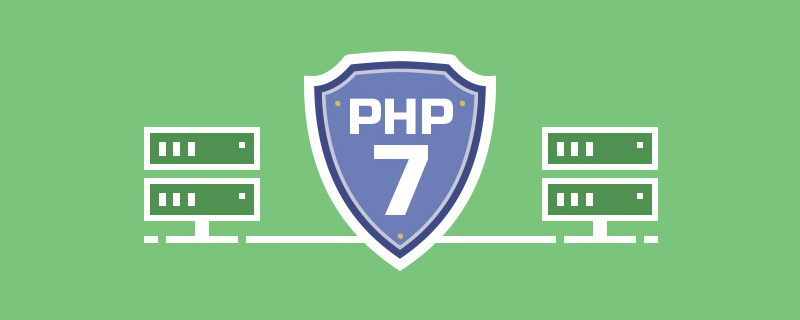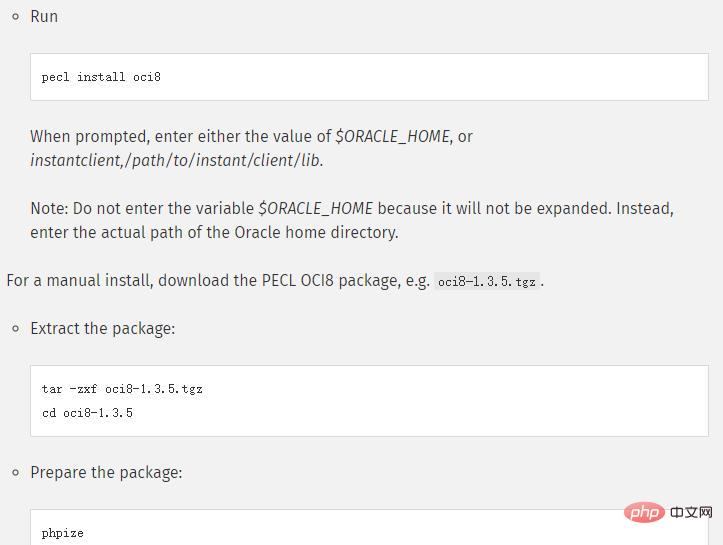Does php7 not have php oci8?
php7 does not have oci8 and needs to be installed and configured. The method for installing oci8 extension in php7 is: 1. Download and install "oracle-instantclient19.5-basic-19.5.0.0.0-1.x86_64.rpm"; 2 , add environment variables; 3. Search for oci8 directly on the PHP official website; 4. Install oci8 through the "pecl install oci8" command.

The operating environment of this tutorial: centos7 system, PHP7 version, Dell G3 computer.
php7 does not have php oci8?
Requires installation and configuration.
php7 Install extension-oci8 Steps and methods:
1. Basic environment
Environment: centos7 PHP 7.2.24
2 . oracle client
2.1 Official address
https://www.oracle.com/database/technologies/instant-client/linux-x86-64-downloads.html
uses the latest version - Version 19.5.0.0.0, both must be installed, the devel version is SDK
oracle-instantclient19.5-basic-19.5.0.0.0-1.x86_64.rpm oracle-instantclient19.5-devel-19.5.0.0.0-1.x86_64.rpm
2.2 Installation
rpm -ivh oracle-instantclient19.5-basic-19.5.0.0.0-1.x86_64.rpm rpm -ivh oracle-instantclient19.5-devel-19.5.0.0.0-1.x86_64.rpm
After the installation is completed, the default path is –/usr/lib/oracle/19.5/client64. I have not added environment variables. If necessary, add them according to your own configuration.
vim /etc/profile source /etc/profile
3. oci8 extension
The installation of online articles is quite confusing. Go to the PHP official website and directly search for oci8 and the results will appear;

3.1 Installation
The first method I took was pecl install oci8; the installation process will always show Please provide the path to the ORACLE_HOME directory. Use 'instantclient,/path/to/instant/client/lib' if you 're compiling with Oracle Instant Client [autodetect]: Just enter the client path address according to the official instructions: instantclient,/usr/lib/oracle/19.5/client64/lib

3.2 Check
After the installation is completed, use –php -m to check whether the installation is successful. Enter the directory –/usr/lib64/php/modules and check whether –oci8.so exists;
Restart If it fails later, you can add extension-extension=oci8.so in the /etc/php.ini file.
3.3 Restart php-fpm
Recommended learning: "PHP Video Tutorial"
The above is the detailed content of Does php7 not have php oci8?. For more information, please follow other related articles on the PHP Chinese website!

Hot AI Tools

Undresser.AI Undress
AI-powered app for creating realistic nude photos

AI Clothes Remover
Online AI tool for removing clothes from photos.

Undress AI Tool
Undress images for free

Clothoff.io
AI clothes remover

AI Hentai Generator
Generate AI Hentai for free.

Hot Article

Hot Tools

Notepad++7.3.1
Easy-to-use and free code editor

SublimeText3 Chinese version
Chinese version, very easy to use

Zend Studio 13.0.1
Powerful PHP integrated development environment

Dreamweaver CS6
Visual web development tools

SublimeText3 Mac version
God-level code editing software (SublimeText3)

Hot Topics
 How to solve the problem when php7 detects that the tcp port is not working
Mar 22, 2023 am 09:30 AM
How to solve the problem when php7 detects that the tcp port is not working
Mar 22, 2023 am 09:30 AM
In php5, we can use the fsockopen() function to detect the TCP port. This function can be used to open a network connection and perform some network communication. But in php7, the fsockopen() function may encounter some problems, such as being unable to open the port, unable to connect to the server, etc. In order to solve this problem, we can use the socket_create() function and socket_connect() function to detect the TCP port.
 How to install mongo extension in php7.0
Nov 21, 2022 am 10:25 AM
How to install mongo extension in php7.0
Nov 21, 2022 am 10:25 AM
How to install the mongo extension in php7.0: 1. Create the mongodb user group and user; 2. Download the mongodb source code package and place the source code package in the "/usr/local/src/" directory; 3. Enter "src/" directory; 4. Unzip the source code package; 5. Create the mongodb file directory; 6. Copy the files to the "mongodb/" directory; 7. Create the mongodb configuration file and modify the configuration.
 What should I do if the plug-in is installed in php7.0 but it still shows that it is not installed?
Apr 02, 2024 pm 07:39 PM
What should I do if the plug-in is installed in php7.0 but it still shows that it is not installed?
Apr 02, 2024 pm 07:39 PM
To resolve the plugin not showing installed issue in PHP 7.0: Check the plugin configuration and enable the plugin. Restart PHP to apply configuration changes. Check the plugin file permissions to make sure they are correct. Install missing dependencies to ensure the plugin functions properly. If all other steps fail, rebuild PHP. Other possible causes include incompatible plugin versions, loading the wrong version, or PHP configuration issues.
 How to install and deploy php7.0
Nov 30, 2022 am 09:56 AM
How to install and deploy php7.0
Nov 30, 2022 am 09:56 AM
How to install and deploy php7.0: 1. Go to the PHP official website to download the installation version corresponding to the local system; 2. Extract the downloaded zip file to the specified directory; 3. Open the command line window and go to the "E:\php7" directory Just run the "php -v" command.
 Which one is better, php8 or php7?
Nov 16, 2023 pm 03:09 PM
Which one is better, php8 or php7?
Nov 16, 2023 pm 03:09 PM
Compared with PHP7, PHP8 has some advantages and improvements in terms of performance, new features and syntax improvements, type system, error handling and extensions. However, choosing which version to use depends on your specific needs and project circumstances. Detailed introduction: 1. Performance improvement, PHP8 introduces the Just-in-Time (JIT) compiler, which can improve the execution speed of the code; 2. New features and syntax improvements, PHP8 supports the declaration of named parameters and optional parameters, making functions Calling is more flexible; anonymous classes, type declarations of properties, etc. are introduced.
 PHP Server Environment FAQ Guide: Quickly Solve Common Problems
Apr 09, 2024 pm 01:33 PM
PHP Server Environment FAQ Guide: Quickly Solve Common Problems
Apr 09, 2024 pm 01:33 PM
Common solutions for PHP server environments include ensuring that the correct PHP version is installed and that relevant files have been copied to the module directory. Disable SELinux temporarily or permanently. Check and configure PHP.ini to ensure that necessary extensions have been added and set up correctly. Start or restart the PHP-FPM service. Check the DNS settings for resolution issues.
 Record once and use strace to diagnose the problem of PHP occupying too much system resources.
May 03, 2024 pm 04:31 PM
Record once and use strace to diagnose the problem of PHP occupying too much system resources.
May 03, 2024 pm 04:31 PM
Local environment: redhat6.7 system. nginx1.12.1, php7.1.0, the code uses the yii2 framework problem: the local web site needs to use the elasticsearch service. When PHP uses elasticsearch built on a local server, the local load is normal. When I use AWS's elasticsearch service, the load on the local server is often too high. Check the nginx and php logs and find no exceptions. The number of concurrent connections in the system is also not high. At this time, I thought of a strace diagnostic tool that our boss told me. Debugging process: Find a php sub-process idstrace-
 How to automatically set permissions of unixsocket after system restart?
Mar 31, 2025 pm 11:54 PM
How to automatically set permissions of unixsocket after system restart?
Mar 31, 2025 pm 11:54 PM
How to automatically set the permissions of unixsocket after the system restarts. Every time the system restarts, we need to execute the following command to modify the permissions of unixsocket: sudo...






